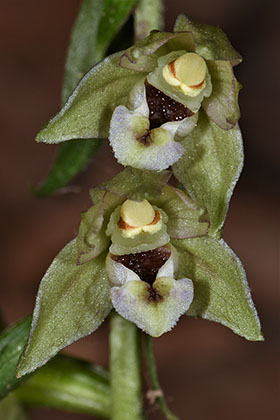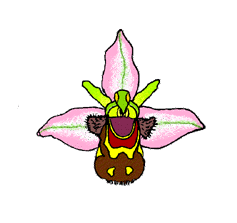Pianta non molto alta (raramente oltre 30 cm), con scapo sottile ma robusto, di color verde chiaro, con pubescenza leggera in basso e densa in alto. In basso 1-2 foglie orbicolari a base guainante, cauline intermedie (4-5) da largamente lanceolate a ovate, acute, da orizzontali a semierette, le più lunghe con estremità arcuate verso il basso, generalmente scanalate, con bordi leggermente ondulati; foglia più grande 7-9 × 2-5 cm; foglia superiore strettamente lanceolata, di solito bratteiforme (7 × 1-2 cm). Brattee inferiori più lunghe dei fiori (lunghe fino 6 cm). Infiorescenza lassa, raramente con più di 20 fiori, normalmente aperti e autogami. Tepali ovati e acuti, i sepali 10,5 × 5 mm, di color verde chiaro, a venature e bordi talvolta leggermente sfumati di viola; petali 9 × 5 mm, talvolta diretti in avanti a nascondere la colonna, da verde chiaro a biancastri, a volte leggermente macchiati di rosso o rosa soprattutto verso il margine. Labello con giunzione ipo-epichilo a forma di U di medie dimensioni, con un ampio colletto; ipochilo ed epichilo delle stesse dimensioni (3-4 × 3-4 mm), l’ipochilo globoso con poco nettare, verde-biancastro all’esterno e verde-brunastro internamente, a volte con bordi arrossati; l’epichilo largamente triangolare, ad apice acuto e spesso ripiegato verso il basso, bianco, verdastro alla base con rigonfiamenti brunastri o verdi, talvolta bicolori, poco sviluppati, asimmetrici, simili a verruche. Clinandrio e rostello ridotti, viscidio evidente a inizio antesi ma mai funzionante, presto nascosto dai pollinii e rapidamente rinsecchito; stigma da rettangolare a ovato e leggermente incavato; antera subsessile; pollinii rapidamente rigonfi, compatti abbastanza a lungo. Non rari gli esemplari sterili.
Protologo di Vito Antonio Romano, Stefan Hertel e
Helmut Presser 2021:
Epipactis ariosica V.A. Romano, S.Hertel & H. Presser spec. nov., die Arioso-Ständelwurz
Holotypus: Italien, Basilikata, NE Sasso di Castalda, alt. s. m. 1175 m. UTM 0561794/4484940 (WGS 84). 04.08.2018, leg. Helmut Presser. In herb. UNIBAS hinterlegt.
Description: Small to medium sized plants, 15-30 (50) cm high. The stem is strong and rather thick; especially in smaller plants it usually curved in places; pure green, lightly covered with white fluffy hairs at the base, but more densely covered higher up.
Usually, the plants have 1-2 almost orbicular leaves sheathing the stem base; 4-5 further leaves, broad lanceolate to ovate, rarely roundish, acute, green, held +/-horizontally to ascending, the longer leaves having downwardly curved tips; usually grooved, with slightly undulate edges; largest leaf 7- 9 cm long and 2-5 cm wide. The petioles are always green. There is usually also one upper bract-like leaf, up to 7 cm long and 1-2 cm wide, lanceolate to narrow lanceolate, acute.
The inflorescence covers one quarter to nearly half of the plant height; rather lax with (3) 5-20 (33) flowers. The flowers are opened normally to very wide.
The pedicel is green, rarely bronze. The ovary is pale green to green, almost glabrous.
The bracts are lanceolate, held +/-horizontally, mostly the same length as the flowers except the lowest ones which can be significantly longer, up to 6 cm long.
The sepals are narrow to broad ovate, acute; the lateral ones are ca. 8.5-10.5 mm long and 4-5 mm wide; pale green to green, the veins and edges sometimes slightly stained violet. The petals are narrow to broad ovate, acute, sometimes directed straight forward and hiding the column, pale green to whitish-green, sometimes slightly stained red or pink especially at the edges; 7-9 mm long and 4-5 mm wide.
The hypochile is 3-4 mm x 3-4 mm, orbicular; deeply basin-shaped; whitish-green on the outside, sometimes reddish in the upper part, brownish-green to brown on the inside; containing only a little nectar. The epichile is a broader than the hypochile, broad triangular, acute; the tip is often curved down; ca. 3-4 mm x 3-4mm; white, greenish in the centre with brownish or green bosses, sometimes bicoloured. The bosses are usually weakly developed to almost absent, asymmetrical, wart-like. The connection between epichile and hypochile is usually U-shaped and medium sized, with a broad collar.
The clinandrium and rostellum are somewhat reduced. The viscidium is clearly visible when the flower first opens but never functional and is soon hidden by the swelling pollinia and also quickly dries up. The stigma is rectangular to ovate and slightly concave. The anther has no stalk, or a very short one. The pollinia swell rather quickly to extend over the edge of the clinandrium but stay compact for a relatively long time. Sterile plants are not rare.
⬆︎modif. by S. Hertel & H. Presser, 2021: Weitere Erkenntnisse zur Vielfalt der Epipactis-Arten im südlichen Italien. – Ber. Arbeitskrs. Heim. Orch. 38 (1): 148.

